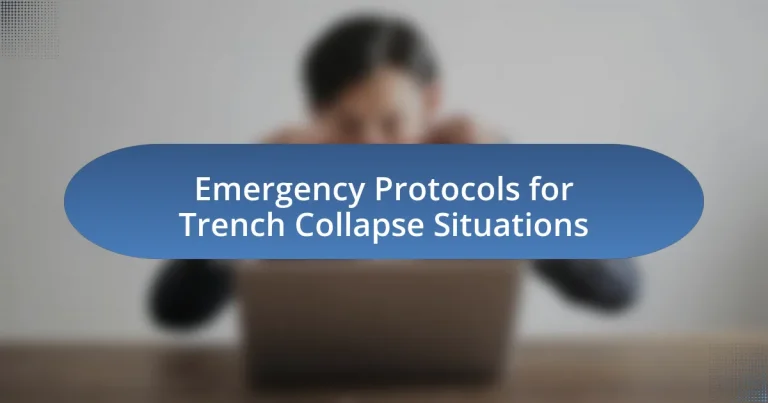Emergency protocols for trench collapse situations are critical for ensuring the safety and rapid rescue of individuals trapped in hazardous conditions. These protocols include immediate evacuation, alerting emergency services, and conducting systematic rescue operations while adhering to safety regulations set by the Occupational Safety and Health Administration (OSHA). The article outlines the risks associated with trench collapses, the importance of proper training, and the key components of effective emergency response, such as communication strategies and logistical considerations. Additionally, it discusses best practices for implementing these protocols and the resources available for developing effective safety measures in trench work environments.

What are Emergency Protocols for Trench Collapse Situations?
Emergency protocols for trench collapse situations include immediate evacuation of the area, alerting emergency services, and conducting a headcount to ensure all personnel are accounted for. Following a trench collapse, workers should not attempt to enter the trench to rescue trapped individuals without proper equipment and training, as this can lead to further collapses. Instead, trained rescue teams should be called to assess the situation and perform the rescue safely. According to the Occupational Safety and Health Administration (OSHA), proper training and adherence to safety regulations can significantly reduce the risk of trench collapses and improve response effectiveness.
Why are Emergency Protocols essential in Trench Collapse Situations?
Emergency protocols are essential in trench collapse situations because they ensure the safety and rapid rescue of individuals trapped in hazardous conditions. These protocols provide clear guidelines for immediate response actions, such as notifying emergency services, securing the site to prevent further collapses, and conducting systematic rescue operations. According to the Occupational Safety and Health Administration (OSHA), trench collapses can occur within seconds, making timely and organized responses critical to minimizing injuries and fatalities. Implementing these protocols can significantly reduce the risk of secondary accidents and enhance the effectiveness of rescue efforts, ultimately saving lives.
What risks are associated with trench collapses?
Trench collapses pose significant risks, primarily including worker injury or fatality, property damage, and disruption of utility services. The Occupational Safety and Health Administration (OSHA) reports that trench collapses can occur within seconds, leading to suffocation or crushing injuries for workers trapped under the soil. Additionally, the collapse can damage nearby structures and utilities, resulting in costly repairs and service interruptions. Statistics indicate that approximately 20% of trench-related fatalities are due to collapses, underscoring the critical need for proper safety measures and protocols in trench work environments.
How do emergency protocols mitigate these risks?
Emergency protocols mitigate risks associated with trench collapse situations by establishing clear procedures for immediate response and safety measures. These protocols include evacuation plans, communication strategies, and designated roles for emergency responders, which ensure that personnel can quickly and effectively address the situation. For instance, the Occupational Safety and Health Administration (OSHA) mandates specific training and safety measures for workers in trenching operations, significantly reducing the likelihood of injuries or fatalities during a collapse. By implementing these protocols, organizations can minimize chaos, enhance coordination among responders, and ultimately protect lives and property during emergencies.
What are the key components of Emergency Protocols for Trench Collapse Situations?
The key components of Emergency Protocols for Trench Collapse Situations include immediate assessment, communication, rescue operations, and post-incident evaluation. Immediate assessment involves determining the extent of the collapse and identifying any trapped individuals. Effective communication ensures that all personnel are informed of the situation and that emergency services are alerted promptly. Rescue operations focus on safely extricating individuals from the trench while minimizing further risk. Post-incident evaluation is crucial for analyzing the response and improving future protocols, ensuring compliance with safety regulations such as those outlined by the Occupational Safety and Health Administration (OSHA), which mandates specific safety measures for trench work to prevent collapses.
What immediate actions should be taken following a trench collapse?
Following a trench collapse, the immediate actions include ensuring the safety of all personnel, calling emergency services, and initiating rescue operations. First, assess the scene for hazards to prevent further injuries. Next, alert emergency responders to provide medical assistance and specialized rescue teams. If it is safe, attempt to communicate with any trapped individuals to assess their condition. Additionally, establish a perimeter to keep unauthorized personnel away from the collapse site, ensuring that only trained responders are present. These actions are critical to minimize risks and facilitate a swift rescue, as outlined in safety protocols established by organizations such as the Occupational Safety and Health Administration (OSHA).
Who should be involved in the emergency response team?
The emergency response team for trench collapse situations should include trained personnel such as emergency medical technicians (EMTs), firefighters, structural engineers, and hazardous materials specialists. These professionals are essential because EMTs provide immediate medical care, firefighters assist in rescue operations, structural engineers assess the stability of the trench, and hazardous materials specialists ensure safety from potential toxic substances. Their combined expertise is crucial for effective response and victim recovery in such emergencies.
How can training improve the effectiveness of Emergency Protocols?
Training enhances the effectiveness of Emergency Protocols by ensuring that responders are well-prepared to execute procedures efficiently during trench collapse situations. Regular training sessions familiarize personnel with specific protocols, improve their decision-making skills under pressure, and increase their confidence in handling emergencies. For instance, a study by the National Institute for Occupational Safety and Health (NIOSH) found that organizations with comprehensive training programs experienced a 30% reduction in response time during emergencies. This evidence demonstrates that effective training directly correlates with improved emergency response outcomes, ultimately saving lives and minimizing injuries in trench collapse incidents.
What types of training are necessary for workers and responders?
Workers and responders require specialized training in safety protocols, hazard recognition, and emergency response procedures for trench collapse situations. This training includes understanding trench safety regulations, such as those outlined by the Occupational Safety and Health Administration (OSHA), which mandates that workers receive instruction on the proper use of protective systems, soil analysis, and the identification of potential hazards. Additionally, responders must be trained in rescue techniques specific to trench collapses, including the use of shoring equipment and the implementation of safe extraction methods to minimize risk during rescue operations.
How often should training be conducted to ensure preparedness?
Training should be conducted at least quarterly to ensure preparedness for trench collapse situations. Regular training sessions help reinforce knowledge of emergency protocols, improve response times, and maintain skill proficiency among personnel. Research indicates that frequent training enhances retention of critical safety procedures, with studies showing that organizations conducting quarterly drills experience a 30% increase in effective response rates during emergencies compared to those with less frequent training.
What are the common challenges faced during trench collapse emergencies?
Common challenges faced during trench collapse emergencies include the difficulty in accessing trapped individuals, the risk of secondary collapses, and the need for rapid stabilization of the trench. Accessing trapped individuals is complicated by the unstable conditions, which can hinder rescue efforts and increase the risk to rescuers. Secondary collapses pose a significant threat, as the initial collapse can destabilize surrounding soil, leading to further incidents. Rapid stabilization is crucial to prevent additional injuries and to create a safe environment for rescue operations. These challenges are underscored by statistics indicating that trench collapses account for a significant number of construction-related fatalities, emphasizing the importance of effective emergency protocols.
How can communication issues impact the response?
Communication issues can significantly delay and hinder the response to trench collapse situations. When responders fail to effectively communicate critical information, such as the location of victims or the status of the site, it can lead to confusion and misallocation of resources. For instance, a study by the National Institute for Occupational Safety and Health (NIOSH) highlights that poor communication during emergencies can result in increased response times by up to 30%, ultimately affecting the safety and survival of individuals trapped in a trench collapse. Therefore, clear and timely communication is essential for coordinating rescue efforts and ensuring the safety of both victims and responders.
What logistical challenges may arise in rescue operations?
Logistical challenges in rescue operations often include limited access to the site, inadequate resources, and coordination difficulties among multiple agencies. Limited access can arise from debris, unstable ground, or hazardous conditions, which impede the movement of personnel and equipment. Inadequate resources may manifest as insufficient medical supplies, rescue tools, or personnel trained for specific situations, leading to delays in response. Coordination difficulties occur when various agencies, such as fire, police, and medical teams, must work together, often resulting in miscommunication or overlapping efforts. These challenges can significantly hinder the effectiveness and efficiency of rescue operations in trench collapse situations.
How do Emergency Protocols evolve based on past incidents?
Emergency protocols evolve based on past incidents through systematic analysis and integration of lessons learned. For example, after the 2006 trench collapse in New York City that resulted in fatalities, regulatory bodies revised safety standards and training requirements for excavation work. This incident highlighted the need for improved monitoring and enforcement of safety measures, leading to the implementation of stricter guidelines, such as the requirement for protective systems in trenching operations. Additionally, data from past incidents is often compiled into reports that inform future training programs and emergency response strategies, ensuring that protocols are continuously updated to mitigate risks and enhance worker safety.
What lessons have been learned from previous trench collapse situations?
Lessons learned from previous trench collapse situations emphasize the critical importance of proper safety measures and protocols. Key findings indicate that implementing trench protective systems, such as shoring or shielding, significantly reduces the risk of collapse. For instance, the Occupational Safety and Health Administration (OSHA) reports that approximately 75% of trench-related fatalities occur in unprotected trenches. Additionally, regular training and safety audits for workers have proven effective in minimizing accidents, as evidenced by a decrease in incidents in companies that prioritize ongoing education. Furthermore, effective communication and emergency response plans are essential, as they ensure quick action can be taken in the event of a collapse, thereby reducing potential injuries and fatalities.
How can these lessons inform future protocol updates?
Lessons learned from past trench collapse incidents can significantly inform future protocol updates by identifying key areas for improvement in safety measures and response strategies. For instance, analyzing previous collapses reveals that inadequate soil assessment and lack of proper shoring techniques were common factors contributing to accidents. By incorporating comprehensive soil analysis protocols and mandating the use of advanced shoring systems, future updates can enhance worker safety and reduce the likelihood of collapses. Furthermore, data from the Occupational Safety and Health Administration (OSHA) indicates that training programs focused on hazard recognition and emergency response have led to a 30% decrease in trench-related fatalities over the past decade. This evidence supports the need for regular training updates and drills as part of revised protocols, ensuring that workers are well-prepared for potential emergencies.
What best practices should be followed in Emergency Protocols for Trench Collapse Situations?
In emergency protocols for trench collapse situations, the best practices include immediate evacuation of personnel from the area, alerting emergency services, and establishing a safe perimeter to prevent further injuries. These actions are critical as they ensure the safety of workers and facilitate a swift response from trained rescue teams. According to the Occupational Safety and Health Administration (OSHA), proper training and preparedness can significantly reduce the risks associated with trench collapses, which can occur suddenly and without warning. Additionally, utilizing trench boxes or shoring systems during excavation work can prevent collapses, thereby enhancing overall safety.
How can regular drills enhance readiness for trench collapse emergencies?
Regular drills enhance readiness for trench collapse emergencies by ensuring that workers are familiar with safety protocols and emergency response procedures. These drills provide practical experience, allowing personnel to practice evacuation routes, use of rescue equipment, and communication strategies in a controlled environment. Research indicates that regular training can improve response times and reduce panic during actual emergencies, as evidenced by a study published in the Journal of Safety Research, which found that organizations conducting frequent drills had a 30% faster response rate in emergency situations compared to those that did not. This preparedness ultimately leads to increased safety and reduced risk of injury or fatalities during trench collapse incidents.
What role does equipment maintenance play in emergency preparedness?
Equipment maintenance is crucial in emergency preparedness as it ensures that all tools and machinery function correctly during critical situations. Regular maintenance minimizes the risk of equipment failure, which can lead to delays in response times and increased hazards during emergencies, such as trench collapses. For instance, the Occupational Safety and Health Administration (OSHA) emphasizes that properly maintained equipment can significantly reduce accidents and improve safety outcomes in construction environments. Therefore, consistent equipment maintenance directly contributes to effective emergency response and enhances overall safety protocols.
What resources are available for developing effective Emergency Protocols?
Resources available for developing effective Emergency Protocols include guidelines from organizations such as the Occupational Safety and Health Administration (OSHA), which provides standards for trench safety and emergency response. Additionally, the National Institute for Occupational Safety and Health (NIOSH) offers research and recommendations specifically addressing trench collapse scenarios. Training programs from the American Red Cross and local emergency management agencies also serve as valuable resources, equipping personnel with the necessary skills to respond effectively. Furthermore, industry-specific manuals and case studies can provide insights into best practices and lessons learned from past incidents, enhancing the development of robust emergency protocols.
Where can organizations find guidelines and standards for trench safety?
Organizations can find guidelines and standards for trench safety through the Occupational Safety and Health Administration (OSHA) and the American National Standards Institute (ANSI). OSHA provides specific regulations under 29 CFR Part 1926, which outlines safety requirements for trenching and excavation work. ANSI also offers standards, such as ANSI/ASSP A10.12, which focuses on safety requirements for excavation and trenching operations. These resources are essential for ensuring compliance and promoting safe practices in trench work.
How can collaboration with local authorities improve emergency response?
Collaboration with local authorities can significantly enhance emergency response by streamlining communication and resource allocation during trench collapse situations. When local authorities are involved, they can provide immediate access to critical resources such as specialized equipment, trained personnel, and logistical support, which are essential for effective rescue operations. For instance, studies have shown that coordinated efforts between emergency services and local government can reduce response times by up to 30%, thereby increasing the chances of saving lives. Additionally, local authorities often have established protocols and relationships with community organizations that can assist in managing the aftermath of such incidents, ensuring a more comprehensive and efficient response.
What practical tips can enhance the implementation of Emergency Protocols?
To enhance the implementation of Emergency Protocols for trench collapse situations, organizations should conduct regular training drills and simulations. These drills ensure that all personnel are familiar with the protocols and can respond effectively during an actual emergency. Research indicates that frequent practice can improve response times by up to 50%, as noted in a study by the National Institute for Occupational Safety and Health (NIOSH). Additionally, clear communication channels must be established to facilitate quick information sharing among team members, which is crucial in high-stress situations. Implementing a checklist for emergency procedures can also help ensure that no critical steps are overlooked during a response.


